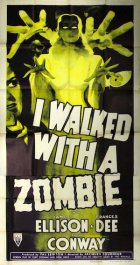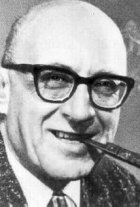
I Walked with a Zombie Page #11
- APPROVED
- Year:
- 1943
- 69 min
- 649 Views
BETSY:
You've never said anything about
voodoo before, Mrs. Rand.
MRS. RAND
Haven't I? I suppose I take it for
granted. It's just part of everyday
life here.
BETSY:
You don't believe in it?
MRS. RAND
A missionary's widow? It isn't
very likely, is it?
BETSY:
I don't mean believe, like
believing in a religion. I mean,
do you believe it has power? Do
you think it could heal a sick
person?
MRS. RAND
(looking hard at Betsy for
a moment)
Frankly, my dear, I didn't expect
anything like this from a nice
level-headed girl. What are you
driving at?
BETSY:
I heard the servants talking about
someone called Mama Rose. They said
she had been "mindless"...
MRS. RAND
Her son drowned. She brooded until
her mind was affected. All the
Houngan did was coax her out of it
with a little practical psychology.
PAGES ARE MISSING AT THIS POINT AS BETSY AND
JESSICA LEAVE FORT HOLLAND AND TRAVEL ACROSS THE SUGAR CANE
FIELDS TO THE HOUMFORT
EXT. THE HOUMFORT - NIGHT
LONG SHOT. The camera is behind Betsy and Jessica as they go
toward the Houmfort through the sugar cane. We see this
voodoo temple as they go toward it. It is a rickety
structure of poles and laths, roofed over with a thin thatch
of sugar cane and straw. It forms a sort of rude pergola.
In the center of this structure is a small, cubicle hut, made
of rough boards but neatly whitewashed. From the rafters of
the main structure hang crude chandeliers of tin which give
light to the ceremonies.
(Please see pages 28 to 31, Life Magazine, December 13, 1937.
All the details mentioned above are graphically illustrated,
Near the little hut in the center of the Houmfort, stands an
altar covered with a lace tablecloth and littered with a
childish jumble of plates, candles, little colored stones and
bottles. Before this altar stands the Houngan, the high
priest of the voodoo ceremonies, a small, stoop-shouldered
man in a worn, white coat and trousers with ragged cuffs.
Several mild-looking negroes in white trousers and shirts sit
in kitchen chairs on one side of the altar with rada drums
between their knees. Grouped around this altar in a loose
semicircle are the worshippers, a group of mild-mannered,
poorly-but-neatly-dressed negroes. They seem to have made an
effort to dress in their best and their best is very poor
indeed. As Betsy approaches, she can see familiar faces.
As she comes up they turn and look at her. They are not
hostile nor greatly surprised; just mildly curious. Leading
Jessica by the hand, Betsy takes her place at one end of the
semicircle around the altar. Her arrival has in no way
interrupted the ceremonies. The Houngan continues to chant
before the altar, the rada drums beat and the crowd sings the
chorus of the Shango song at the proper intervals. It is all
very decorous and decidedly religious in tone. No sooner has
Betsy taken her place with the others than the Shango ritual
approaches its climax. The Sabreur, a colored man dressed in
white shirt and trousers, with a neat dark tie knotted under
his collar, comes in, bearing a sabre in his right hand,
holding it in stately, almost processional manner. He
advances to the altar, strikes it three times and at this
signal two colored women dressed in white beguine dresses
with square cut necks, an essential part of this religious
costume, come forward. One holds a white leghorn chicken and
the other carries a white rooster. They come together to the
altar and for a moment, the figures of the Houngan, the
Sabreur and the two Mam-Lois hide the actual blood sacrifice
from us. Only the fact that the drumming and the singing
reach a climactic pitch reveal that some Important portion of
the ceremony has taken place. Instantly the drumming and the
singing stops. A young colored girl jumps up from her seat
among the worshippers and begins shivering and quaking,
crying out wordlessly. There is a cry from the people.
THE PEOPLE:
Put the god in her! Put the god in
her!
The Houngan prances forward, followed by the Sabreur. The
Houngan holds a little saucer in his hand with some dark
liquid at the bottom of it. He dips four fingers into this
liquid while the girl quivers and writhes before him in
religious ecstasy. He marks her forehead with four strange
marks, one with each finger. The Sabreur, crying out the
name of Shango, four times, points his sabre to the four
directions of the compass. There is an immediate
transformation in the girl. Her frenzy ceases. She seems to
be filled with a jubilant calm and dances into the cleared
space before the altar. Her words are no longer meaningless.
They have taken shape and form and, when she speaks, she
speaks with great resonance as if her voice came from
somewhere other than her own throat. She is possessed by the
god, Shango.
One by one, people from among the group of devotees dance
into the circle, go up to her and beg for favors. One woman
leads a little boy up to her. We hear her words as she calls
out to the possessed girl:
WOMAN:
Make him rich, Shango! Make him
rich!
The girl lays her fingers on the boy's eyes, and then takes
his shoulders and turns him around three times, Evidently
this is absolute guarantee of an enormous income tax to be
paid at St. Sebastian. The woman and her son retire happily,
pleased and grinning. Finally, exhausted, the girl possessed
of the god, Shango, sinks to her knees and then falls
fainting to the floor. Two colored men come in, carry her
away. A great cry rises from the voodoo worshippers.
WORSHIPPERS:
Damballa! Damballa! Damballa!
Damballa!
The drums find a new rhythm. The Houngan retires to one
corner of the altar; the Sabreur to the other. Two young
girls, their beguine dresses slashed and torn, dance in from
either side. This is a wild and an impassioned dance, a
dance to Damballa. There is no singing, only an occasional
call from the crowd, "Come to us, Damballa!" The dancers
reach the climax of their dance and strike a plastic pose
before the altar, each kneeling on one knee, their arms held
to their breasts, their foreheads butted together. Although
not a muscle moves, one can almost feel the tension of these
two bodies. One of the rada drummers comes up and crouches
down holding a small drum almost under the chins of the two
girls.
The other drummers stop playing and he begins to beat a quick
staccato rhythm that grows faster and faster. In this
playing, as in the pose of the girls, there is tremendous
tension. By now all cries have ceased. Everyone is silent,
waiting. Then suddenly, from behind the closed and curiously
painted door of the inner Houmfort, a voice speaks. A voice
that is light, pleasant and authoritative.
VOICE:
(muffled by the door)
Where are my people? Let them
bring me the rice cakes -- let them
dance and be happy --
There is a great ecstatic shout from the voodoo worshippers.
Translation
Translate and read this script in other languages:
Select another language:
- - Select -
- 简体中文 (Chinese - Simplified)
- 繁體中文 (Chinese - Traditional)
- Español (Spanish)
- Esperanto (Esperanto)
- 日本語 (Japanese)
- Português (Portuguese)
- Deutsch (German)
- العربية (Arabic)
- Français (French)
- Русский (Russian)
- ಕನ್ನಡ (Kannada)
- 한국어 (Korean)
- עברית (Hebrew)
- Gaeilge (Irish)
- Українська (Ukrainian)
- اردو (Urdu)
- Magyar (Hungarian)
- मानक हिन्दी (Hindi)
- Indonesia (Indonesian)
- Italiano (Italian)
- தமிழ் (Tamil)
- Türkçe (Turkish)
- తెలుగు (Telugu)
- ภาษาไทย (Thai)
- Tiếng Việt (Vietnamese)
- Čeština (Czech)
- Polski (Polish)
- Bahasa Indonesia (Indonesian)
- Românește (Romanian)
- Nederlands (Dutch)
- Ελληνικά (Greek)
- Latinum (Latin)
- Svenska (Swedish)
- Dansk (Danish)
- Suomi (Finnish)
- فارسی (Persian)
- ייִדיש (Yiddish)
- հայերեն (Armenian)
- Norsk (Norwegian)
- English (English)
Citation
Use the citation below to add this screenplay to your bibliography:
Style:MLAChicagoAPA
"I Walked with a Zombie" Scripts.com. STANDS4 LLC, 2024. Web. 25 Dec. 2024. <https://www.scripts.com/script/i_walked_with_a_zombie_875>.



Discuss this script with the community:
Report Comment
We're doing our best to make sure our content is useful, accurate and safe.
If by any chance you spot an inappropriate comment while navigating through our website please use this form to let us know, and we'll take care of it shortly.
Attachment
You need to be logged in to favorite.
Log In